Design Thinking Report: Evaluating Ticket Vending Machine Design
VerifiedAdded on 2023/03/17
|8
|1981
|36
Report
AI Summary
This report explores design thinking principles through the evaluation of ticket vending machines (TVMs). The study examines user interactions, common errors, and the application of design thinking stages such as empathize, define, ideate, prototype, and test. The analysis focuses on a specific TVM that offers a wide range of ticket options and payment methods, observing user behavior and identifying usability issues. The report discusses two button-pressing systems and evaluates the efficiency and user-friendliness of the interface. It highlights the importance of user-centered design, emphasizing that a well-designed interface is crucial for efficient and satisfying user experiences. The report also explores how cognitive psychology principles can improve complex systems, and concludes that a multi-button system is more suitable for users who are not experts. The findings are based on observations, interviews, and analysis of user errors, providing valuable insights for designers and ergonomists involved in creating such machines. This report is a valuable resource for anyone studying user experience, human-computer interaction, or design thinking.
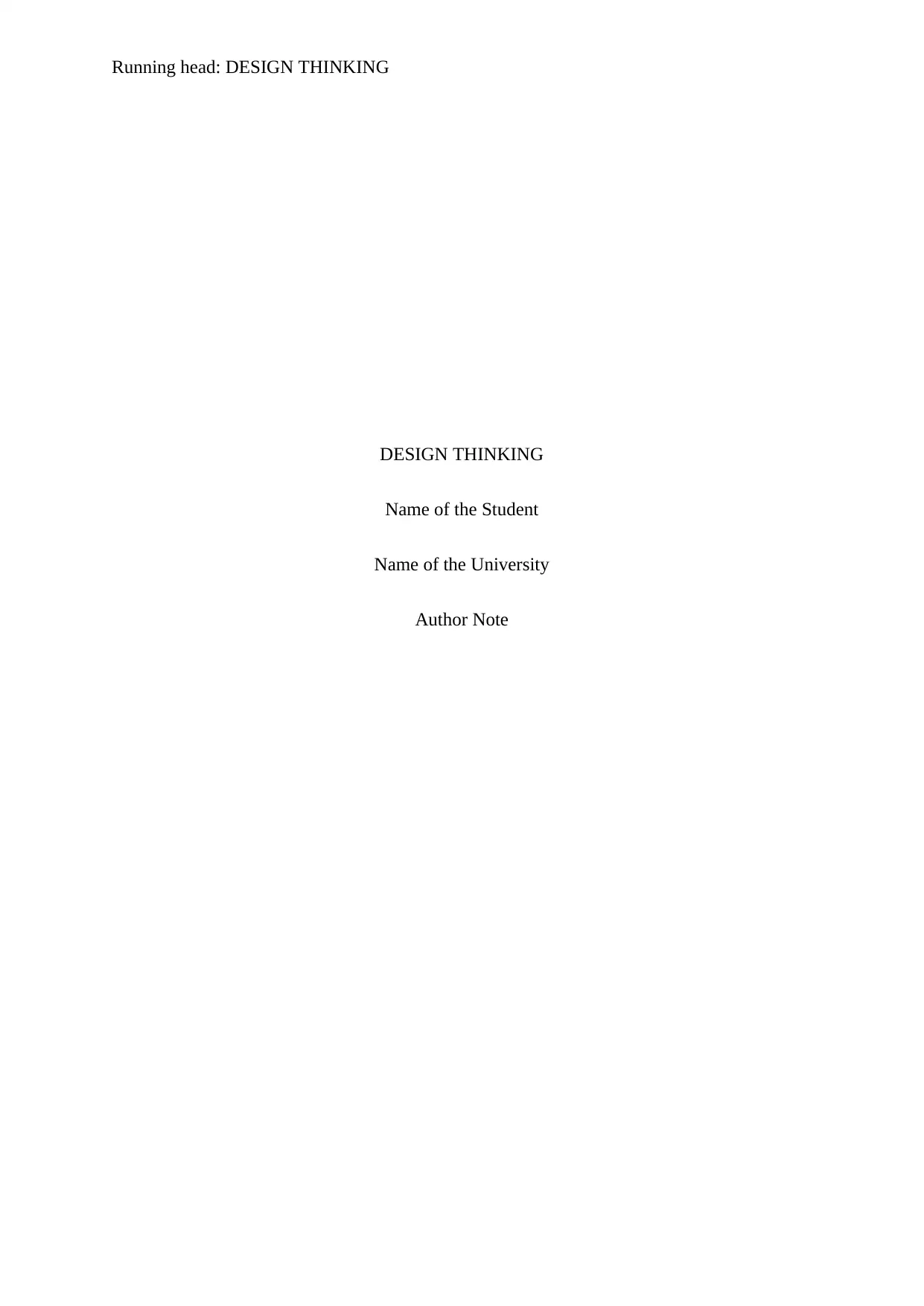
Running head: DESIGN THINKING
DESIGN THINKING
Name of the Student
Name of the University
Author Note
DESIGN THINKING
Name of the Student
Name of the University
Author Note
Secure Best Marks with AI Grader
Need help grading? Try our AI Grader for instant feedback on your assignments.
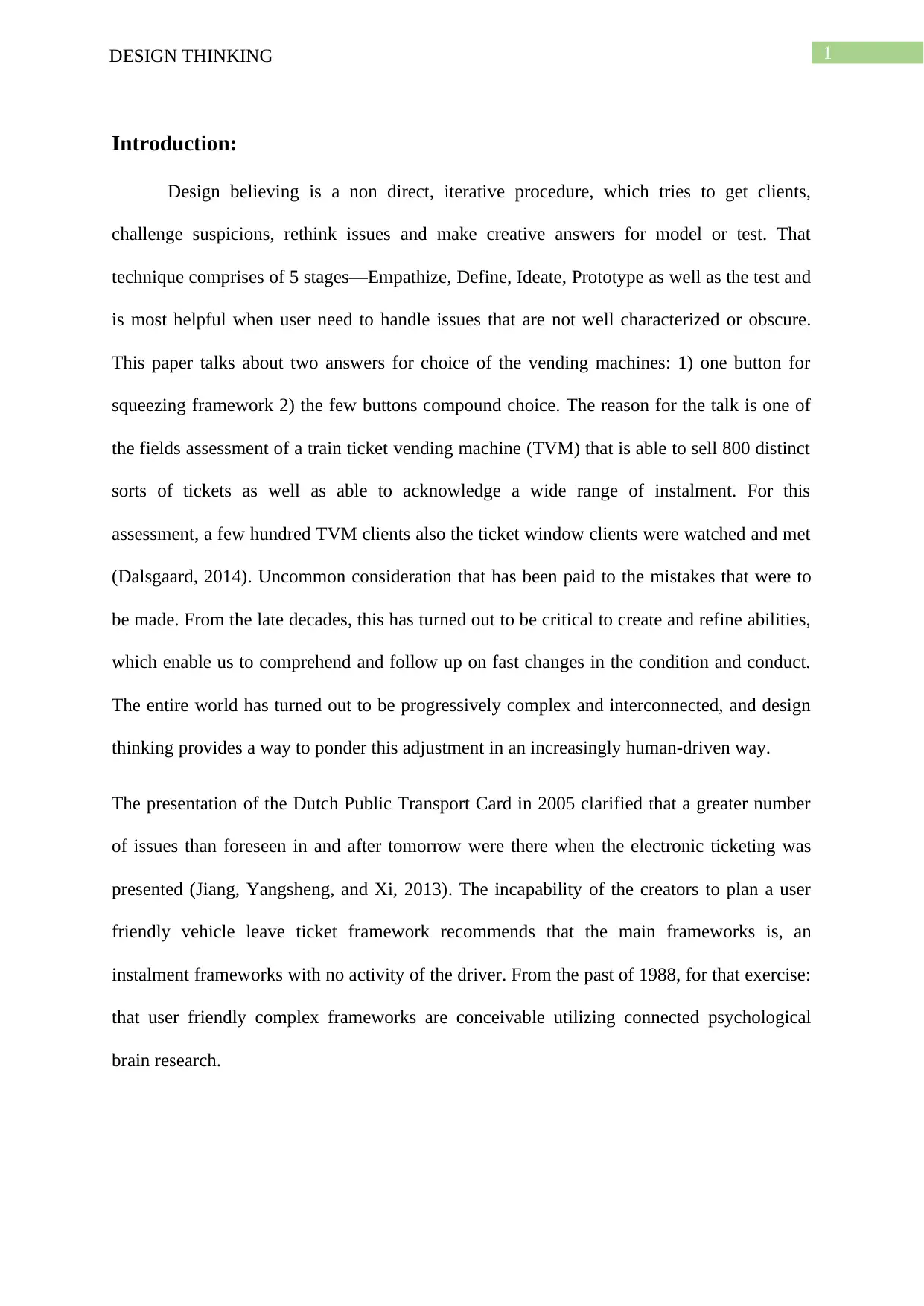
DESIGN THINKING 1
Introduction:
Design believing is a non direct, iterative procedure, which tries to get clients,
challenge suspicions, rethink issues and make creative answers for model or test. That
technique comprises of 5 stages—Empathize, Define, Ideate, Prototype as well as the test and
is most helpful when user need to handle issues that are not well characterized or obscure.
This paper talks about two answers for choice of the vending machines: 1) one button for
squeezing framework 2) the few buttons compound choice. The reason for the talk is one of
the fields assessment of a train ticket vending machine (TVM) that is able to sell 800 distinct
sorts of tickets as well as able to acknowledge a wide range of instalment. For this
assessment, a few hundred TVM clients also the ticket window clients were watched and met
(Dalsgaard, 2014). Uncommon consideration that has been paid to the mistakes that were to
be made. From the late decades, this has turned out to be critical to create and refine abilities,
which enable us to comprehend and follow up on fast changes in the condition and conduct.
The entire world has turned out to be progressively complex and interconnected, and design
thinking provides a way to ponder this adjustment in an increasingly human-driven way.
The presentation of the Dutch Public Transport Card in 2005 clarified that a greater number
of issues than foreseen in and after tomorrow were there when the electronic ticketing was
presented (Jiang, Yangsheng, and Xi, 2013). The incapability of the creators to plan a user
friendly vehicle leave ticket framework recommends that the main frameworks is, an
instalment frameworks with no activity of the driver. From the past of 1988, for that exercise:
that user friendly complex frameworks are conceivable utilizing connected psychological
brain research.
Introduction:
Design believing is a non direct, iterative procedure, which tries to get clients,
challenge suspicions, rethink issues and make creative answers for model or test. That
technique comprises of 5 stages—Empathize, Define, Ideate, Prototype as well as the test and
is most helpful when user need to handle issues that are not well characterized or obscure.
This paper talks about two answers for choice of the vending machines: 1) one button for
squeezing framework 2) the few buttons compound choice. The reason for the talk is one of
the fields assessment of a train ticket vending machine (TVM) that is able to sell 800 distinct
sorts of tickets as well as able to acknowledge a wide range of instalment. For this
assessment, a few hundred TVM clients also the ticket window clients were watched and met
(Dalsgaard, 2014). Uncommon consideration that has been paid to the mistakes that were to
be made. From the late decades, this has turned out to be critical to create and refine abilities,
which enable us to comprehend and follow up on fast changes in the condition and conduct.
The entire world has turned out to be progressively complex and interconnected, and design
thinking provides a way to ponder this adjustment in an increasingly human-driven way.
The presentation of the Dutch Public Transport Card in 2005 clarified that a greater number
of issues than foreseen in and after tomorrow were there when the electronic ticketing was
presented (Jiang, Yangsheng, and Xi, 2013). The incapability of the creators to plan a user
friendly vehicle leave ticket framework recommends that the main frameworks is, an
instalment frameworks with no activity of the driver. From the past of 1988, for that exercise:
that user friendly complex frameworks are conceivable utilizing connected psychological
brain research.
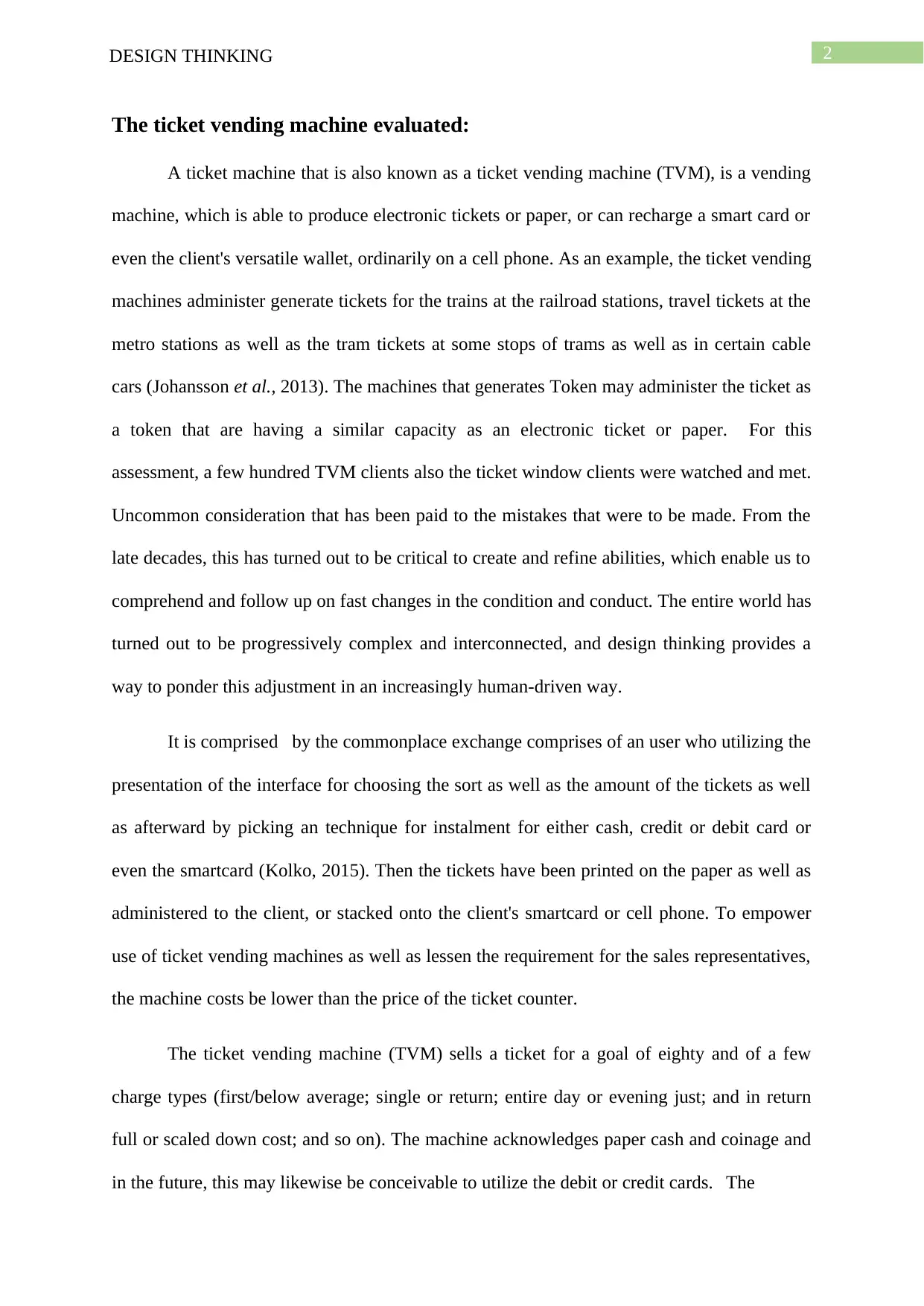
2DESIGN THINKING
The ticket vending machine evaluated:
A ticket machine that is also known as a ticket vending machine (TVM), is a vending
machine, which is able to produce electronic tickets or paper, or can recharge a smart card or
even the client's versatile wallet, ordinarily on a cell phone. As an example, the ticket vending
machines administer generate tickets for the trains at the railroad stations, travel tickets at the
metro stations as well as the tram tickets at some stops of trams as well as in certain cable
cars (Johansson et al., 2013). The machines that generates Token may administer the ticket as
a token that are having a similar capacity as an electronic ticket or paper. For this
assessment, a few hundred TVM clients also the ticket window clients were watched and met.
Uncommon consideration that has been paid to the mistakes that were to be made. From the
late decades, this has turned out to be critical to create and refine abilities, which enable us to
comprehend and follow up on fast changes in the condition and conduct. The entire world has
turned out to be progressively complex and interconnected, and design thinking provides a
way to ponder this adjustment in an increasingly human-driven way.
It is comprised by the commonplace exchange comprises of an user who utilizing the
presentation of the interface for choosing the sort as well as the amount of the tickets as well
as afterward by picking an technique for instalment for either cash, credit or debit card or
even the smartcard (Kolko, 2015). Then the tickets have been printed on the paper as well as
administered to the client, or stacked onto the client's smartcard or cell phone. To empower
use of ticket vending machines as well as lessen the requirement for the sales representatives,
the machine costs be lower than the price of the ticket counter.
The ticket vending machine (TVM) sells a ticket for a goal of eighty and of a few
charge types (first/below average; single or return; entire day or evening just; and in return
full or scaled down cost; and so on). The machine acknowledges paper cash and coinage and
in the future, this may likewise be conceivable to utilize the debit or credit cards. The
The ticket vending machine evaluated:
A ticket machine that is also known as a ticket vending machine (TVM), is a vending
machine, which is able to produce electronic tickets or paper, or can recharge a smart card or
even the client's versatile wallet, ordinarily on a cell phone. As an example, the ticket vending
machines administer generate tickets for the trains at the railroad stations, travel tickets at the
metro stations as well as the tram tickets at some stops of trams as well as in certain cable
cars (Johansson et al., 2013). The machines that generates Token may administer the ticket as
a token that are having a similar capacity as an electronic ticket or paper. For this
assessment, a few hundred TVM clients also the ticket window clients were watched and met.
Uncommon consideration that has been paid to the mistakes that were to be made. From the
late decades, this has turned out to be critical to create and refine abilities, which enable us to
comprehend and follow up on fast changes in the condition and conduct. The entire world has
turned out to be progressively complex and interconnected, and design thinking provides a
way to ponder this adjustment in an increasingly human-driven way.
It is comprised by the commonplace exchange comprises of an user who utilizing the
presentation of the interface for choosing the sort as well as the amount of the tickets as well
as afterward by picking an technique for instalment for either cash, credit or debit card or
even the smartcard (Kolko, 2015). Then the tickets have been printed on the paper as well as
administered to the client, or stacked onto the client's smartcard or cell phone. To empower
use of ticket vending machines as well as lessen the requirement for the sales representatives,
the machine costs be lower than the price of the ticket counter.
The ticket vending machine (TVM) sells a ticket for a goal of eighty and of a few
charge types (first/below average; single or return; entire day or evening just; and in return
full or scaled down cost; and so on). The machine acknowledges paper cash and coinage and
in the future, this may likewise be conceivable to utilize the debit or credit cards. The
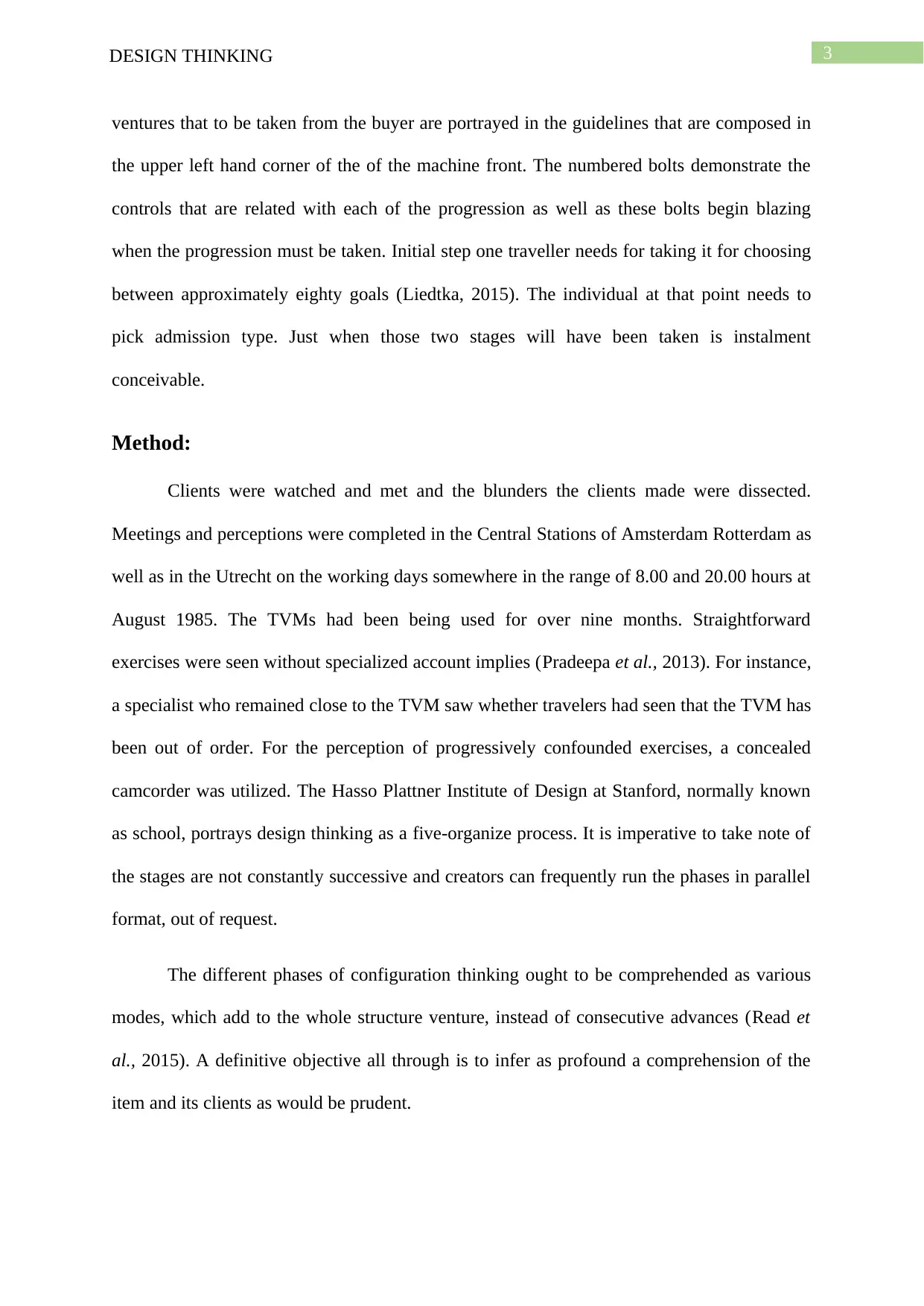
3DESIGN THINKING
ventures that to be taken from the buyer are portrayed in the guidelines that are composed in
the upper left hand corner of the of the machine front. The numbered bolts demonstrate the
controls that are related with each of the progression as well as these bolts begin blazing
when the progression must be taken. Initial step one traveller needs for taking it for choosing
between approximately eighty goals (Liedtka, 2015). The individual at that point needs to
pick admission type. Just when those two stages will have been taken is instalment
conceivable.
Method:
Clients were watched and met and the blunders the clients made were dissected.
Meetings and perceptions were completed in the Central Stations of Amsterdam Rotterdam as
well as in the Utrecht on the working days somewhere in the range of 8.00 and 20.00 hours at
August 1985. The TVMs had been being used for over nine months. Straightforward
exercises were seen without specialized account implies (Pradeepa et al., 2013). For instance,
a specialist who remained close to the TVM saw whether travelers had seen that the TVM has
been out of order. For the perception of progressively confounded exercises, a concealed
camcorder was utilized. The Hasso Plattner Institute of Design at Stanford, normally known
as school, portrays design thinking as a five-organize process. It is imperative to take note of
the stages are not constantly successive and creators can frequently run the phases in parallel
format, out of request.
The different phases of configuration thinking ought to be comprehended as various
modes, which add to the whole structure venture, instead of consecutive advances (Read et
al., 2015). A definitive objective all through is to infer as profound a comprehension of the
item and its clients as would be prudent.
ventures that to be taken from the buyer are portrayed in the guidelines that are composed in
the upper left hand corner of the of the machine front. The numbered bolts demonstrate the
controls that are related with each of the progression as well as these bolts begin blazing
when the progression must be taken. Initial step one traveller needs for taking it for choosing
between approximately eighty goals (Liedtka, 2015). The individual at that point needs to
pick admission type. Just when those two stages will have been taken is instalment
conceivable.
Method:
Clients were watched and met and the blunders the clients made were dissected.
Meetings and perceptions were completed in the Central Stations of Amsterdam Rotterdam as
well as in the Utrecht on the working days somewhere in the range of 8.00 and 20.00 hours at
August 1985. The TVMs had been being used for over nine months. Straightforward
exercises were seen without specialized account implies (Pradeepa et al., 2013). For instance,
a specialist who remained close to the TVM saw whether travelers had seen that the TVM has
been out of order. For the perception of progressively confounded exercises, a concealed
camcorder was utilized. The Hasso Plattner Institute of Design at Stanford, normally known
as school, portrays design thinking as a five-organize process. It is imperative to take note of
the stages are not constantly successive and creators can frequently run the phases in parallel
format, out of request.
The different phases of configuration thinking ought to be comprehended as various
modes, which add to the whole structure venture, instead of consecutive advances (Read et
al., 2015). A definitive objective all through is to infer as profound a comprehension of the
item and its clients as would be prudent.
Secure Best Marks with AI Grader
Need help grading? Try our AI Grader for instant feedback on your assignments.

4DESIGN THINKING
Results:
A few sorts of issue can happen in the cooperation between planning travellers and a
passage ticket vending machine. As example the developers have seen that:
Data introduced by the framework can not be seen from the client;
Data important to the exchange however not exhibited by the framework, may not be
accessible in client's memory of long haul;
Client's errands can not be obviously exhibited to them;
Clients is not able to play out all errands in the right request.
These problems result in:
Surrendering the activity, that occurred for 13% of the first run through clients.
longer buy time;
disappointment;
Wrongly requested tickets.
Discussion:
A one-catch framework can comprise of a rundown in that for each component all
determinations are exhibited on or close to a button that is related. On the TVM assessed, this
arrangement is utilized for the choice of the passage type (first or inferior; single or return;
entire day or evening just return; full or marked down price). Three catches: one for class,
one for yes/no, one for single/return.
Another button to squeeze framework is the grid type framework. Here likewise for each mix
of components there is just a single catch (Read et al., 2013). In any case, the data that has a
place with this catch is situated somewhere else - for example toward the beginning of a
rundown or to one side edge as well as at the highest point of the grid.
Results:
A few sorts of issue can happen in the cooperation between planning travellers and a
passage ticket vending machine. As example the developers have seen that:
Data introduced by the framework can not be seen from the client;
Data important to the exchange however not exhibited by the framework, may not be
accessible in client's memory of long haul;
Client's errands can not be obviously exhibited to them;
Clients is not able to play out all errands in the right request.
These problems result in:
Surrendering the activity, that occurred for 13% of the first run through clients.
longer buy time;
disappointment;
Wrongly requested tickets.
Discussion:
A one-catch framework can comprise of a rundown in that for each component all
determinations are exhibited on or close to a button that is related. On the TVM assessed, this
arrangement is utilized for the choice of the passage type (first or inferior; single or return;
entire day or evening just return; full or marked down price). Three catches: one for class,
one for yes/no, one for single/return.
Another button to squeeze framework is the grid type framework. Here likewise for each mix
of components there is just a single catch (Read et al., 2013). In any case, the data that has a
place with this catch is situated somewhere else - for example toward the beginning of a
rundown or to one side edge as well as at the highest point of the grid.
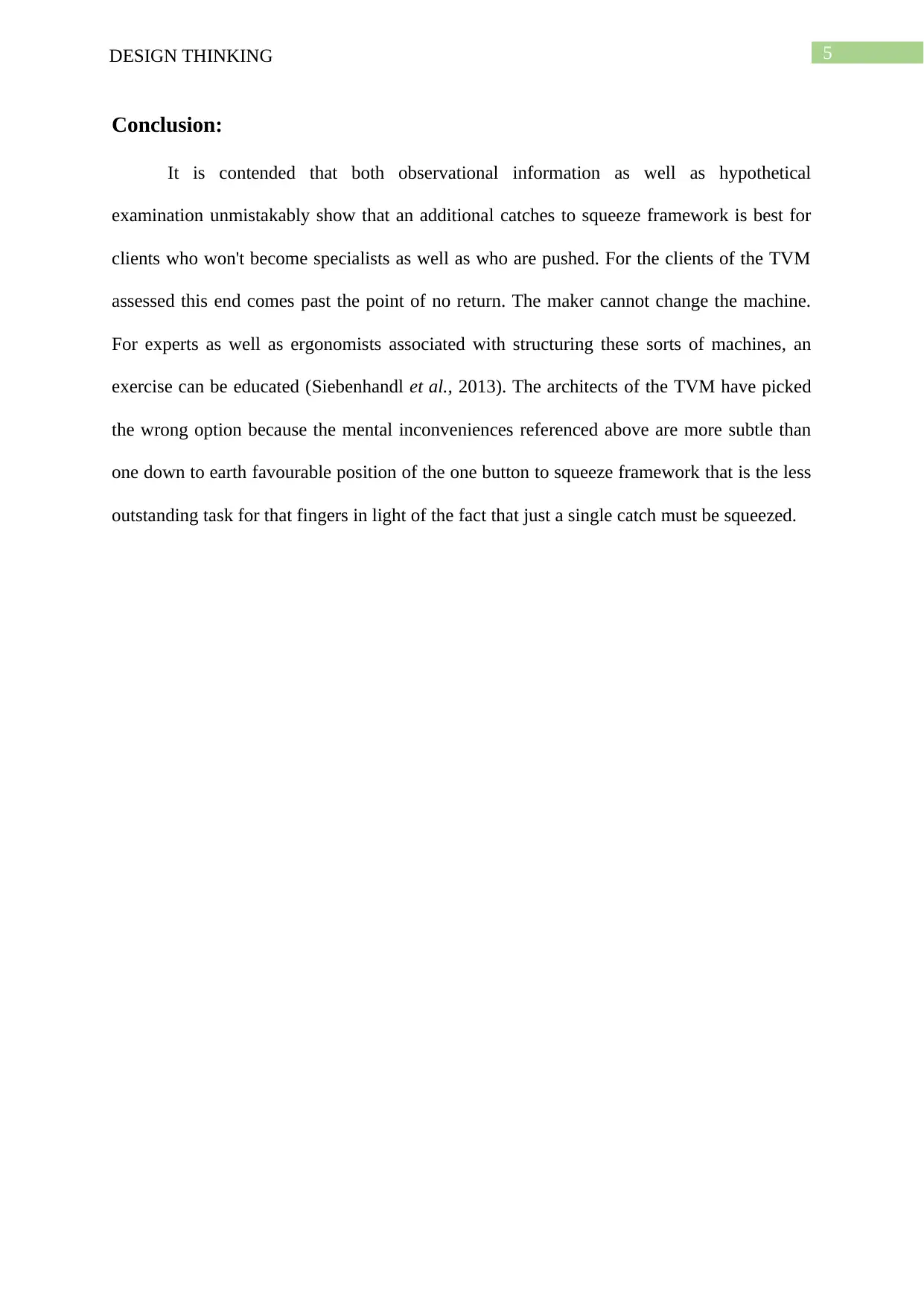
5DESIGN THINKING
Conclusion:
It is contended that both observational information as well as hypothetical
examination unmistakably show that an additional catches to squeeze framework is best for
clients who won't become specialists as well as who are pushed. For the clients of the TVM
assessed this end comes past the point of no return. The maker cannot change the machine.
For experts as well as ergonomists associated with structuring these sorts of machines, an
exercise can be educated (Siebenhandl et al., 2013). The architects of the TVM have picked
the wrong option because the mental inconveniences referenced above are more subtle than
one down to earth favourable position of the one button to squeeze framework that is the less
outstanding task for that fingers in light of the fact that just a single catch must be squeezed.
Conclusion:
It is contended that both observational information as well as hypothetical
examination unmistakably show that an additional catches to squeeze framework is best for
clients who won't become specialists as well as who are pushed. For the clients of the TVM
assessed this end comes past the point of no return. The maker cannot change the machine.
For experts as well as ergonomists associated with structuring these sorts of machines, an
exercise can be educated (Siebenhandl et al., 2013). The architects of the TVM have picked
the wrong option because the mental inconveniences referenced above are more subtle than
one down to earth favourable position of the one button to squeeze framework that is the less
outstanding task for that fingers in light of the fact that just a single catch must be squeezed.
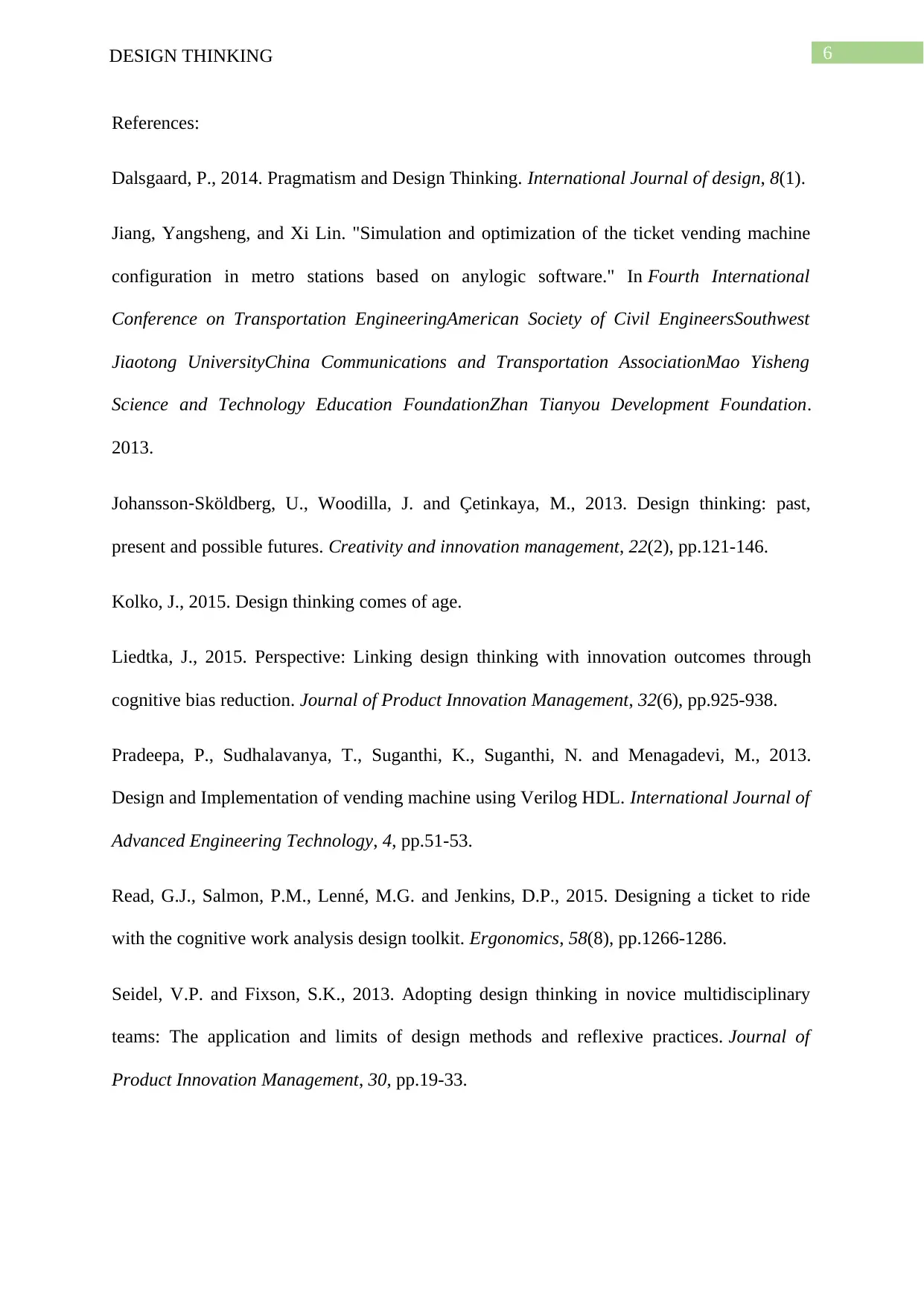
6DESIGN THINKING
References:
Dalsgaard, P., 2014. Pragmatism and Design Thinking. International Journal of design, 8(1).
Jiang, Yangsheng, and Xi Lin. "Simulation and optimization of the ticket vending machine
configuration in metro stations based on anylogic software." In Fourth International
Conference on Transportation EngineeringAmerican Society of Civil EngineersSouthwest
Jiaotong UniversityChina Communications and Transportation AssociationMao Yisheng
Science and Technology Education FoundationZhan Tianyou Development Foundation.
2013.
Johansson‐Sköldberg, U., Woodilla, J. and Çetinkaya, M., 2013. Design thinking: past,
present and possible futures. Creativity and innovation management, 22(2), pp.121-146.
Kolko, J., 2015. Design thinking comes of age.
Liedtka, J., 2015. Perspective: Linking design thinking with innovation outcomes through
cognitive bias reduction. Journal of Product Innovation Management, 32(6), pp.925-938.
Pradeepa, P., Sudhalavanya, T., Suganthi, K., Suganthi, N. and Menagadevi, M., 2013.
Design and Implementation of vending machine using Verilog HDL. International Journal of
Advanced Engineering Technology, 4, pp.51-53.
Read, G.J., Salmon, P.M., Lenné, M.G. and Jenkins, D.P., 2015. Designing a ticket to ride
with the cognitive work analysis design toolkit. Ergonomics, 58(8), pp.1266-1286.
Seidel, V.P. and Fixson, S.K., 2013. Adopting design thinking in novice multidisciplinary
teams: The application and limits of design methods and reflexive practices. Journal of
Product Innovation Management, 30, pp.19-33.
References:
Dalsgaard, P., 2014. Pragmatism and Design Thinking. International Journal of design, 8(1).
Jiang, Yangsheng, and Xi Lin. "Simulation and optimization of the ticket vending machine
configuration in metro stations based on anylogic software." In Fourth International
Conference on Transportation EngineeringAmerican Society of Civil EngineersSouthwest
Jiaotong UniversityChina Communications and Transportation AssociationMao Yisheng
Science and Technology Education FoundationZhan Tianyou Development Foundation.
2013.
Johansson‐Sköldberg, U., Woodilla, J. and Çetinkaya, M., 2013. Design thinking: past,
present and possible futures. Creativity and innovation management, 22(2), pp.121-146.
Kolko, J., 2015. Design thinking comes of age.
Liedtka, J., 2015. Perspective: Linking design thinking with innovation outcomes through
cognitive bias reduction. Journal of Product Innovation Management, 32(6), pp.925-938.
Pradeepa, P., Sudhalavanya, T., Suganthi, K., Suganthi, N. and Menagadevi, M., 2013.
Design and Implementation of vending machine using Verilog HDL. International Journal of
Advanced Engineering Technology, 4, pp.51-53.
Read, G.J., Salmon, P.M., Lenné, M.G. and Jenkins, D.P., 2015. Designing a ticket to ride
with the cognitive work analysis design toolkit. Ergonomics, 58(8), pp.1266-1286.
Seidel, V.P. and Fixson, S.K., 2013. Adopting design thinking in novice multidisciplinary
teams: The application and limits of design methods and reflexive practices. Journal of
Product Innovation Management, 30, pp.19-33.
Paraphrase This Document
Need a fresh take? Get an instant paraphrase of this document with our AI Paraphraser
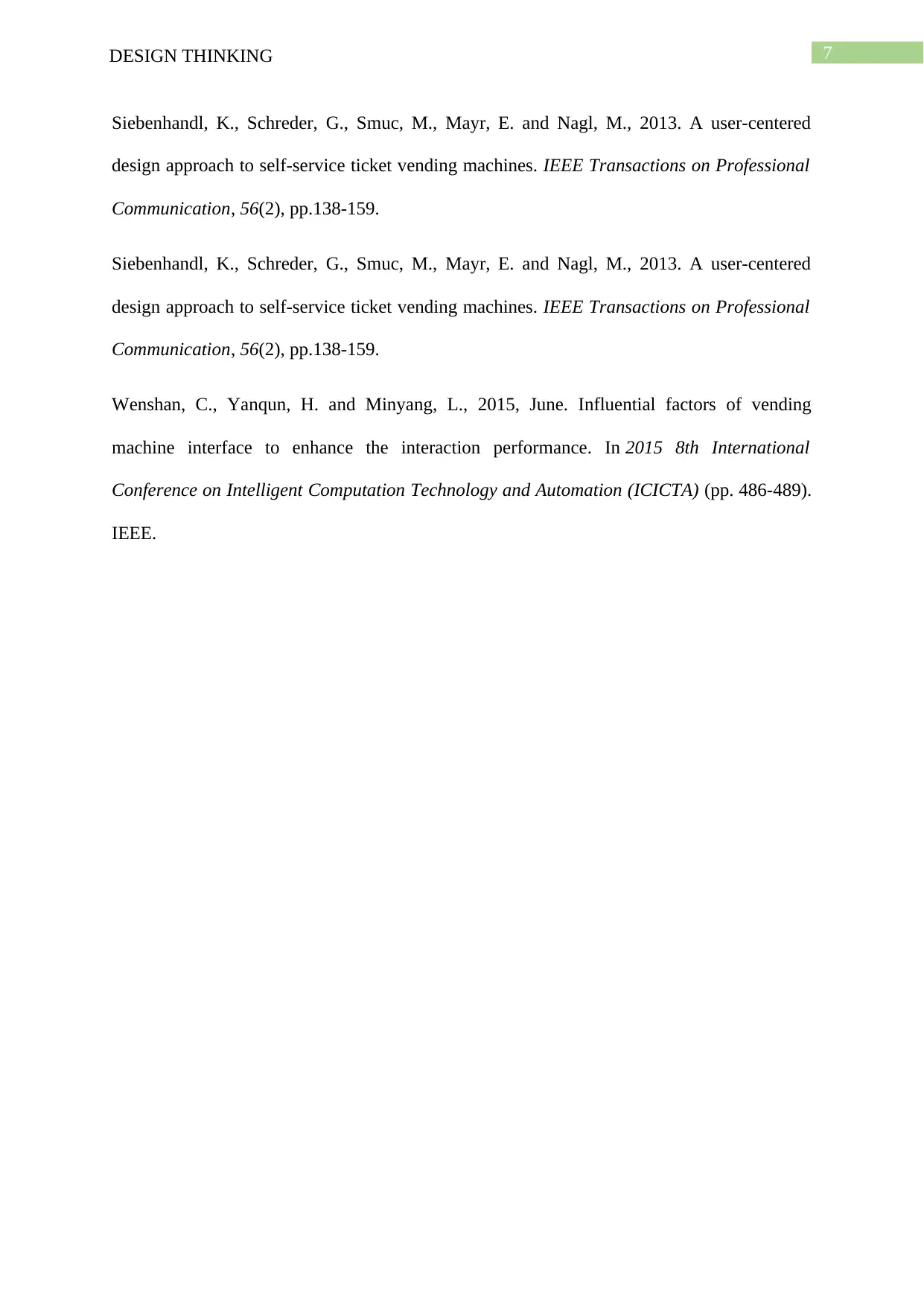
7DESIGN THINKING
Siebenhandl, K., Schreder, G., Smuc, M., Mayr, E. and Nagl, M., 2013. A user-centered
design approach to self-service ticket vending machines. IEEE Transactions on Professional
Communication, 56(2), pp.138-159.
Siebenhandl, K., Schreder, G., Smuc, M., Mayr, E. and Nagl, M., 2013. A user-centered
design approach to self-service ticket vending machines. IEEE Transactions on Professional
Communication, 56(2), pp.138-159.
Wenshan, C., Yanqun, H. and Minyang, L., 2015, June. Influential factors of vending
machine interface to enhance the interaction performance. In 2015 8th International
Conference on Intelligent Computation Technology and Automation (ICICTA) (pp. 486-489).
IEEE.
Siebenhandl, K., Schreder, G., Smuc, M., Mayr, E. and Nagl, M., 2013. A user-centered
design approach to self-service ticket vending machines. IEEE Transactions on Professional
Communication, 56(2), pp.138-159.
Siebenhandl, K., Schreder, G., Smuc, M., Mayr, E. and Nagl, M., 2013. A user-centered
design approach to self-service ticket vending machines. IEEE Transactions on Professional
Communication, 56(2), pp.138-159.
Wenshan, C., Yanqun, H. and Minyang, L., 2015, June. Influential factors of vending
machine interface to enhance the interaction performance. In 2015 8th International
Conference on Intelligent Computation Technology and Automation (ICICTA) (pp. 486-489).
IEEE.
1 out of 8
Your All-in-One AI-Powered Toolkit for Academic Success.
+13062052269
info@desklib.com
Available 24*7 on WhatsApp / Email
![[object Object]](/_next/static/media/star-bottom.7253800d.svg)
Unlock your academic potential
© 2024 | Zucol Services PVT LTD | All rights reserved.